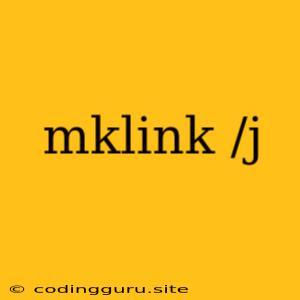Understanding mklink /j
mklink /j is a powerful command in Windows that allows you to create a symbolic link, also known as a junction point. This command is particularly useful for managing files and folders on your system, offering a way to create virtual paths that point to actual locations.
What are symbolic links?
Symbolic links, or symlinks, are like shortcuts for files and folders. They act as pointers to the actual location of the target file or folder. When you access a symbolic link, the operating system automatically redirects you to the linked location.
Why use mklink /j?
There are several reasons why you might want to use mklink /j:
- Organize your files: You can create symbolic links to organize your files and folders across different locations on your system. For example, you can link a folder in your user profile to a directory on a network drive.
- Point to multiple locations: You can create multiple symbolic links that point to the same target location. This can be useful for accessing data from different locations without having to copy the data itself.
- Maintain data integrity: Symbolic links can help maintain data integrity by ensuring that changes made to the linked target are reflected in the symbolic link.
How to use mklink /j
The syntax for using mklink /j is as follows:
mklink /j
Explanation:
<symlink name>: This is the name of the symbolic link you want to create.<target location>: This is the actual location of the file or folder you want to link to.
Example:
Let's say you have a folder called "Documents" on your D drive and you want to create a symbolic link to it in your user profile folder. You can use the following command:
mklink /j "C:\Users\\Documents" "D:\Documents"
This will create a symbolic link named "Documents" in your user profile folder that points to the "Documents" folder on the D drive.
Important notes:
- Junction points can only be used to link to directories, not files.
- You need administrator privileges to create symbolic links.
- You can delete a symbolic link by using the
rmdircommand.
Troubleshooting
If you encounter any issues when using mklink /j, here are some things to keep in mind:
- Make sure you have the correct permissions. You need administrator privileges to create symbolic links.
- Check the target location. Ensure that the target directory exists and you have access to it.
- Avoid creating circular links. This can lead to errors and unpredictable behavior.
- Be careful when deleting symbolic links. Deleting a symbolic link will not delete the linked target.
Summary:
mklink /j is a valuable tool for managing files and folders in Windows. By creating symbolic links, you can organize your files, access data from multiple locations, and maintain data integrity. However, it's important to use this command carefully and to understand its limitations to avoid potential issues.
